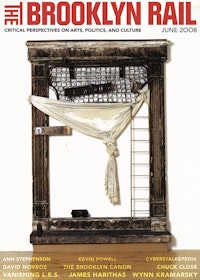ArtSeen
Tomory Dodge
CRG Gallery April 19, 2008 – May 24, 2008

He’s gone a bit more abstract this time, but Tomory Dodge’s six large-scale paintings at CRG will be immediately recognizable to those familiar with his work. There are no rock outcroppings, cacti, or icebergs, but his painterly trademarks are all over: gradated, sky-colored backgrounds traversed by rainbow thatches of striated oil paint. They thrive on contrast, pairing flat, monochromatic backgrounds against networks of directional strokes of variegated color. The resulting figure/ground relationship simulates space so deftly that it borders on the manipulative; the visual allure is so impressive that it almost seems calculated. But then again, painting is inherently manipulative; it affects emotions even at its most abstract, and I wouldn’t be surprised if even Richard Tuttle calculates sometimes. So should it bother us that Tomory Dodge’s handling of paint is so thoroughly seductive?
It probably depends on whether you believe Dodge’s acrobatics are a means toward a more purposeful end or are simply ends in themselves. Indeed, they feel so adroit that you can’t help but think Dodge has reverse-engineered the diverse painterly riffs of Caravaggio, John Singer Sargent and Gerhard Richter to achieve his own synthetic perfection. Dodge’s titles, however, suggest an extra-aesthetic purpose. The show’s most dazzling painting, “Daisy Cutter” (2008), features a deep sky-blue background eclipsed by a vertical curtain of syrupy paint. Despite its sumptuous tactility, the title refers to a 15,000-pound bomb employed by the US military in Vietnam and Afghanistan that mowed down more than just daisies. If the title and the imagery meet just right, the wild, scattered marks might suggest artillery fire or shrapnel, and the painting might evoke thoughts about war and destruction. But if such a scenario isn’t unlocked, material will win out over metaphor and all you’ll see is an ultra-sexy, semi-abstract painting that will give you more of an appetite for a piece of taffy than for world peace.
The same critique could be levied against other paintings at in the show. “Cascade Bravo” (2008) is a slightly more busy and active painting than “Daisy Cutter” but works on the same compositional premises, although it possesses more push/pull ambiguity regarding the superposition of the marks. Buttery, pale strokes crisscross the canvas and its dark blue underpainting supplies some depth. While it doesn’t evoke the combat suggested by its militaristic title, it succeeds more than the others in conveying the visual tumult that we might associate with it.
That said, it’s time to put away the torches and pitchforks and give Dodge a break. His only crime, facing a politically concerned art world, is compensating for having such good chops by borrowing some topicality from outside the realm of non-objective painting. If you overlook this, and define “a more purposeful end” as the transformation of ordinary oil paint into some of the most infectious and tempting compositions you’ll ever see, Tomory Dodge is a huge success. He is a virtuoso. And even if you read these paintings as abstract, they aren’t simply “formal” compositions. They are demonstrations of paint handling and compositional savvy brought to a Wagnerian crescendo. Phil Spector once said that he wanted to make Wagnerian operas for teenagers, and his artistic credibility never suffered. I’ll bet he never had to defend “He’s a Rebel” for not being topical. That was 1962, and one didn’t need to posture as smart enough to predict the end of the world or political enough to save it. In 1962, audiences were more inclined to accept pleasure as an artistic end.
Tomory Dodge’s paintings are luscious, tactile and seductive to the point of irritating a contemporary viewer’s sense of intellectual propriety. They call up the critical Puritan in all of us who would rather not be led into temptation, who would feel more upright praising the heady dryness of, say, Luc Tuymans, or the social politics of Thomas Hirschhorn. But in the end, Dodge’s canvases are too much to resist, and you’ll succumb to their sexy, prurient, gooey, material allure, whether you see them as important commentaries or not.
—Shane McAdams




